8 Leg Press Alternatives for Gym and Home Workouts
The leg press is a popular gym machine because, unlike many lower body exercises, it lets you train your legs without stressing your spine.
While this is beneficial for most weightlifters—exercises that put little pressure on your back are typically easier to recover from—it’s especially beneficial for those with lower back issues, as it allows them to work their quads, hamstrings, glutes, and calves without discomfort.
However, not everyone has access to a leg press machine.
Most people with a garage gym lack the space or budget for a leg press at home, and basic commercial gyms often prioritize simpler equipment like leg extensions and curls.
That’s why it’s helpful to know effective leg press alternatives you can do with other equipment.
So, if you want to learn how to get all the benefits of training with a leg press without a machine, this article is for you.
- The 8 Best Leg Press Alternatives for Gym and Home Workouts
- 1. Hack Squat
- 2. Barbell Front Squat
- 3. Dumbbell Front Squat
- 4. Safety Bar Squat
- 5. Goblet Squat
- 6. Bulgarian Split Squat
- 7. Step-up
- 7. Pendulum Squat
- 8. Belt Squat
- FAQ #1: Is leg press necessary?
- FAQ #2: Can you do the leg press on a cable machine?
- FAQ #3: Is 100 kg leg press good?
- FAQ #4: How can you mimic a leg press at home?
- FAQ #5: Is leg press a good alternative to squats?
Table of Contents
The 8 Best Leg Press Alternatives for Gym and Home Workouts
To be considered a worthy substitute for the leg press, an exercise must . . .
- Allow you to lift heavy weights safely and progress regularly
- Train your entire lower body
- Place minimal stress on your spine
Here are the best 8 exercises that tick these boxes:
1. Hack Squat
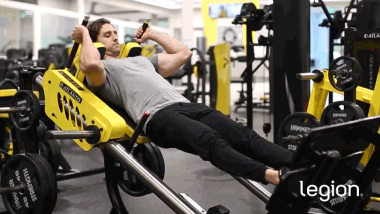
The machine hack squat is an excellent leg press alternative because it’s gentle on your lower back and knees while allowing you to train your entire lower body, especially your quads.
How to:
- Position your body so your feet are shoulder-width apart on the hack squat machine footplate, your toes pointing slightly outward, and your shoulders and back against the pads.
- Straighten your knees and use the safety handles to release the weight.
- Keeping your back against the pad, sit down and push your knees out in the same direction as your toes.
- Stand up and return to the starting position.
2. Barbell Front Squat
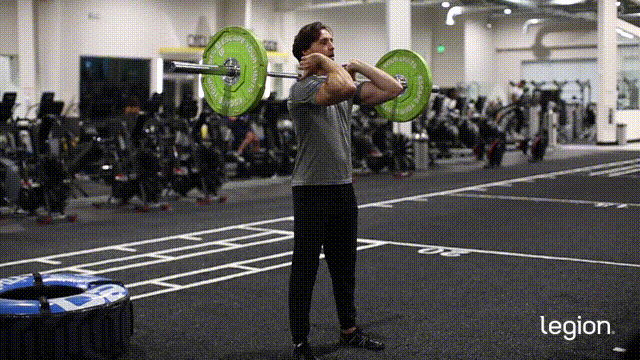
The front squat is a worthy alternative to the leg press because it trains your legs exceptionally well and places little compressive forces on your knees and lower back. In many ways, it’s like a leg press without a machine.
How to:
- Position a barbell in a squat rack at about the height of your breastbone.
- Grab the bar with a shoulder-width grip and your palms facing away from you.
- Step closer to the bar so that it presses against the top of your breastbone, and push your elbows up and out in front of it.
- With the bar resting on the front of your shoulders and held in place by your hands, lift it out of the rack, take 1-to-2 steps backward, and place your feet a little wider than shoulder-width apart with your toes pointing slightly outward.
- Keeping your back straight, sit down and push your knees out in the same direction as your toes.
- Stand up and return to the starting position.
3. Dumbbell Front Squat
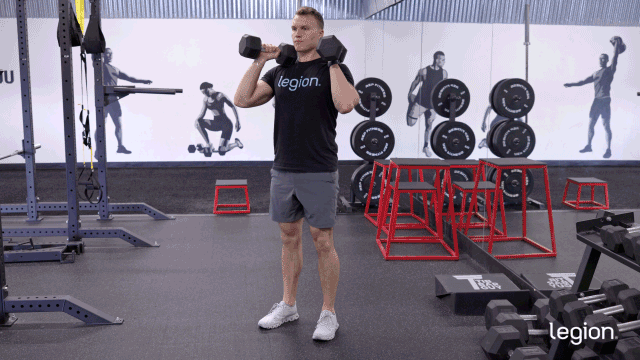
The dumbbell front squat trains your body similarly to the barbell version, but since dumbbells are more accessible than a barbell for most people, the dumbbell front squat is often a more practical alternative to the leg press for people who train at home.
How to:
- Stand upright holding a dumbbell in each hand.
- Hoist the dumbbells to shoulder height with your palms facing each other.
- Position your feet shoulder-width apart with your toes pointing slightly out.
- Keeping your back straight, sit down and push your knees out in the same direction as your toes.
- Stand up and return to the starting position.
4. Safety Bar Squat
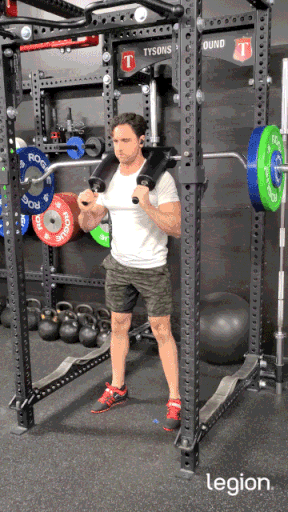
The safety bar squat is an outstanding leg press alternative for people who train in a home gym and don’t have the space or means for a leg press machine. The safety bar holds the plates in a slightly offset position compared to a straight barbell, which relieves stress on your back by allowing you to squat in a more upright position.
How to:
- Position a safety squat bar in a squat rack at about the height of your breastbone.
- Position your head between the two handles with the main bar resting on your upper back, and grab one handle in each hand.
- Unrack the bar, take 1-to-2 steps backward, and place your feet a little wider than shoulder-width apart with your toes pointing slightly outward.
- Keeping your back straight, sit down and push your knees out in the same direction as your toes.
- Stand up and return to the starting position.
5. Goblet Squat
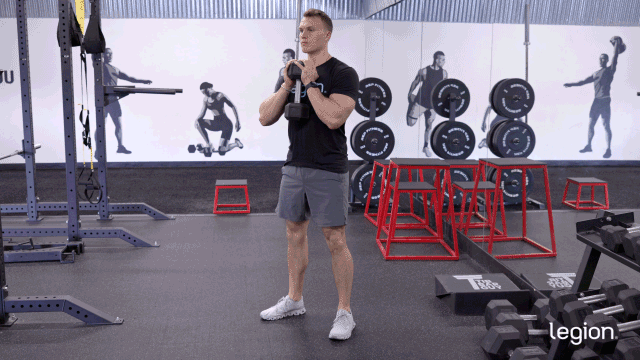
The goblet squat is similar to the front squat, except you use a dumbbell instead of a barbell. Since dumbbells are more common in home gyms, the goblet squat is often a more feasible leg press alternative for people who train at home.
How to:
- Hold a dumbbell in front of your chest with both hands.
- Place your feet a little wider than shoulder-width apart, point your toes slightly outward, and raise your chest.
- Keeping your back straight, sit down and push your knees out in the same direction as your toes.
- Stand up and return to the starting position.
6. Bulgarian Split Squat
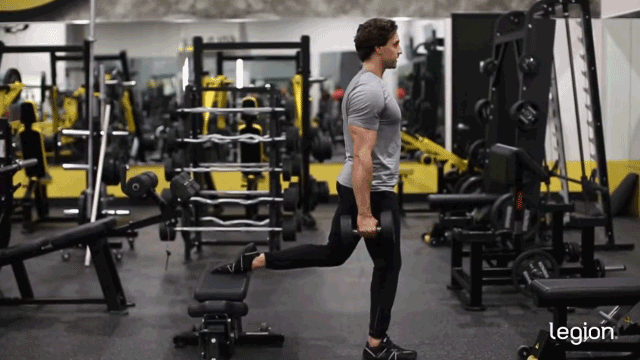
Like the leg press, the Bulgarian split squat trains all the muscle groups in your legs. However, unlike the leg press, the Bulgarian split squat trains each leg separately, so it’s useful for finding and fixing muscle and strength imbalances.
- While holding a dumbbell in each hand, stand about 2-to-3 feet in front of a bench with your back to the bench.
- With your right foot planted, place the top of your left foot on the bench behind you.
- Lower your butt toward the floor by bending your right knee until your right thigh is roughly parallel with the floor.
- Stand up and return to the starting position.
7. Step-up
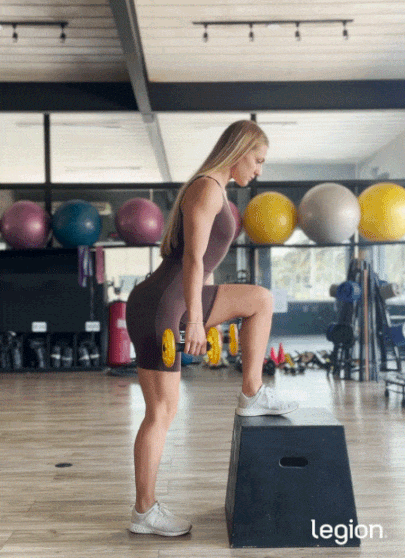
The dumbbell step-up is one of the best leg press alternative exercises because it trains your entire lower body, helps eliminate size and strength imbalances, boosts your squat performance, and since you don’t need to lift much weight to reap the exercise’s benefits, it’s easier on your knees and back than many other lower-body exercises.
How to:
- Hold a dumbbell in each hand, and place your right foot on a box, bench, or other surface about knee height off the floor.
- Keep your weight on your right foot, and fully straighten your right leg.
- Lower your left foot toward the floor and return to the starting position.
7. Pendulum Squat
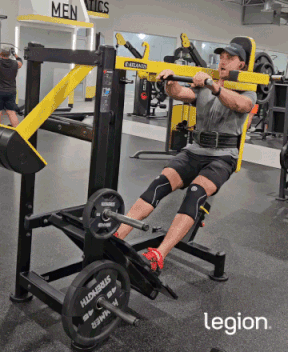
The pendulum squat is another machine leg exercise that trains the lower body similarly to the leg press. The biggest advantage of the pendulum squat is that it has an “inverse resistance curve,” making it hardest at the top of each rep and easiest at the bottom. This means it trains your lower body slightly differently than other leg exercises.
How to:
- Position yourself in the pendulum squat machine with your back against the pad and your shoulders under the shoulder pads.
- Place your feet shoulder-width apart on the footplate with your toes pointing slightly outward.
- Straighten your knees to lift the weight and release the safety handles.
- Keeping your back against the pad, sit down and push your knees out in the same direction as your toes.
- Stand up and return to the starting position.
8. Belt Squat
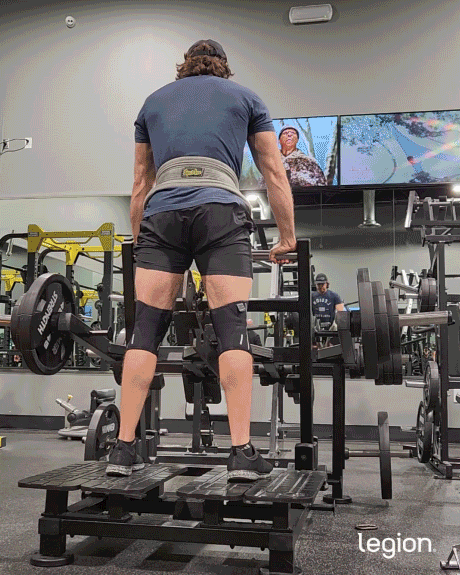
The belt squat is a great leg press alternative because it’s a stable exercise that allows you to squat heavy weights without loading your spine.
How to:
- Stand on the platform facing the machine and loop the belt around your waist.
- Squat down enough to hook the belt to the machine, then position your feet so the belt hangs straight between your legs, your feet are a little wider than shoulder-width apart, and your toes point slightly outward.
- Grab the machine’s handle with both hands, straighten your legs to support the weight, and pull the handle toward you to release the weight.
- Keeping your back straight, sit down and push your knees out in the same direction as your toes.
- Stand up and return to the starting position.
FAQ #1: Is leg press necessary?
No specific exercise is “necessary” for gaining muscle and strength, including the leg press. However, the leg press is a great option if you can do it because it’s easy to learn and perform, allows you to lift heavy weights safely, and enables you to progressively increase the weight you lift over time, which is essential for gaining muscle and strength.
FAQ #2: Can you do the leg press on a cable machine?
You can’t perform the traditional leg press using a cable machine, though you can do exercises that mimic the leg press. For example, the cable front squat trains your entire lower body and only requires a cable machine.
However, exercises that mimic the leg press using a cable machine are typically awkward to perform and require a high degree of balance and coordination to prevent the cable from pulling you over, which is why I typically don’t recommend them.
FAQ #3: Is 100 kg leg press good?
It depends. Leg pressing 100 kg is impressive for someone new to weightlifting, especially for those who aren’t very heavy. However, if you’ve been training for several years, you should have developed enough lower body strength to leg press significantly more than this.
FAQ #4: How can you mimic a leg press at home?
The internet is full of gimmicky, but not necessarily safe or practical, ways of mimicking the leg press at home.
Some methods are straightforward, like using resistance bands while lying on the floor; others involve more complex setups with equipment like landmine attachments and Viking press handles; and still others resemble the “tomb of Hercules,” the exercise that likely led to the invention of the modern leg press.
Unless you’re capable of constructing a reliable home version of a leg press, it’s better to opt for safer, simpler alternatives. The best options are:
- Barbell and dumbbell front squat
- Goblet squat
- Bulgarian split squat
- Step-up
FAQ #5: Is leg press a good alternative to squats?
Yes, the leg press is a good alternative to squats for those with mobility issues or injuries that make squatting difficult. That said, squats train more muscles throughout your entire body and may have more carryover to athletic endeavors. This makes squats slightly more effective for overall muscle, strength, and power development.
The post 8 Leg Press Alternatives for Gym and Home Workouts appeared first on Legion Athletics.
https://ift.tt/kAMGqrm June 17, 2024 at 06:25PM Legion Athletics
Comments
Post a Comment